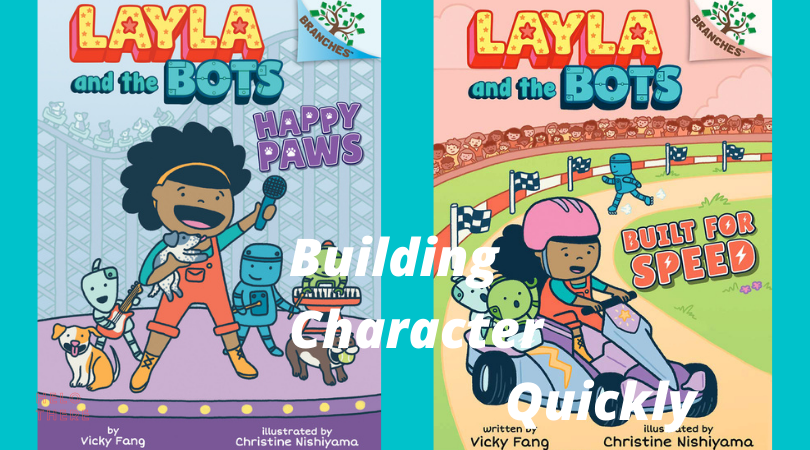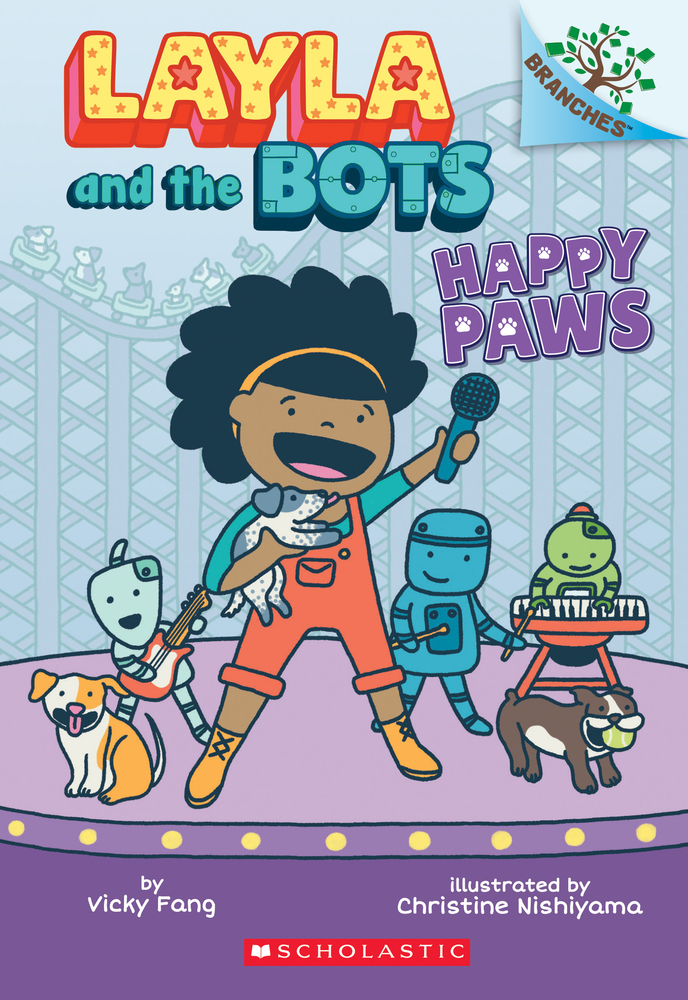craft review by Anne-Marie Strohman
Early Readers and Chapter Books are tricky to write because they are meant to be easy to read, or gauged specifically to kids who read at a certain level of complexity. Because they’re meant for developing readers, they tend to have few words and a neutral narrative voice that uses simple subject-verb sentences. The most obvious way to inject personality into these stories–an absolutely necessary component–is through character. So how do you inject character personality into a story in so few words?
In her early chapter book series Layla and the Bots, Vicky Fang manages to incorporate STEM topics, design thinking, AND interesting characters, all in just over 1500 words each. Let’s take a look at techniques she uses to create interesting and memorable characters.
DEFINITION
First, it helps to define the main characteristics of your characters quickly. In Layla and the Bots, Fang does this in just a few sentences, focusing us on Layla and each of the bots in terms of their interests and skills.
The books start out by introducing the character:
This is Layla. She is an inventor. And a rock star. (1)
We find out very simply what Layla does and what her interests are. This doesn’t give her much of a personality yet, but it clearly defines how she will behave in the book, and it opens the door for more personality later.
Next, we meet the bots, BEEP, BOOP, and BOP. They are also distinguished from each other in the text:
Beep knows things.
Boop builds things.
Bop codes things. (3)
These characteristics and skills stay consistent throughout the story and help readers keep the three bots straight. This strategy allows for more interactions between the bots and among Layla and all three of the bots.
DIALOGUE
When the bots are introduced, each one has a speech bubble.
Beep knows things. “BEEP. Light travels faster than anything else in this world.”
Boop builds things. “More lights?” [Boop is attaching lights to bars.]
Bop codes things. “Ready-yah!” [Bop is sitting in front of a computer with code about lights on the screen.] (Happy Paws 3).
This dialogue reinforces the characteristic and gives each bot a distinct voice. In Built for Speed, the main text is repeated from Happy Paws, but the speech bubble text is different.
Throughout the stories, Beep always starts speech with “BEEP” and then offers knowledge. Boop is most concerned with building things and asking questions, and Bop usually has short exclamations. This dialogue gives each bot a personality and reinforces the characteristic that Fang has highlighted for each character.
The dialogue Layla speaks also establishes her personality.
- She is encouraging, telling the bots “Great work!” (Built for Speed 27).
- She’s analytical and makes decisions: “The motor is not strong enough. We need something stronger” (Built for Speed 30).
- She’s concerned about people and interested in the problems they face. When Layla notices that the owner of Happy Days amusement park looks upset, she asks, “Is everything okay?” Then asks follow up questions, “What? But why?” (Happy Paws 10-11).
- Perhaps most importantly, she is determined. When she finds out her favorite amusement park is in danger of closing, she says, “We are not going to let it happen. We have to save Happy Days! Are you with me?” (13).
We find out about who Layla is through her words and actions, and the dialogue fleshes out what it means to be this particular inventor-rockstar.
DESIRE

The aspect of character perhaps most essential to a story is their desire, and Layla has a clear desire in each book. In Happy Paws, Layla wants to save the Happy Days amusement park. This desire is motivated by her memories of fun times at the park.
In Built for Speed, Layla wants to create a go-kart that will work for Tina, a girl who uses a wheelchair. It’s a less personally motivated desire, but it’s a clear and empathetic desire. She wants Tina to be able to participate, and later in the story wants to figure out how to make the race fair for everybody. The ideas of inclusion and fairness both model and evoke empathy in readers.
These desires provide an engine for the plot. The choices Layla makes and the obstacles and struggles she faces are directly related to these desires.
DOUBT
One other element that humanizes Layla is her doubt. Interestingly, the doubt isn’t included in Layla’s dialogue until late in the story–it is spoken by other characters and kept in the main text.
In Happy Paws, the doubt is introduced by the park owner, Mr. Wade. When Layla suggests making the park fun for dogs, as well as humans, Mr. Wade says,
“But how could we do that? We’d have to redesign the entire park. I don’t think it’s possible. . . . It’s a pretty huge and wild idea.” (26-27)
Then the main text incorporates the doubt: “Layla thinks he might be right. But she has to do something.” Her doubt is matched by determination.
Later in the story, the night before Layla is going to present her plans to Mr. Wade, “she worries . . . Will it be enough to save the park?”
Spoiler: it looks like enough to save the park, but then the safety inspector won’t certify one ride. The doubt moves from the main text into Layla’s speech bubbles. She owns up to her failure:
“I’m sorry I let you down. I let us all down.” (58)
After hearing something one of the bots says, she has an a-ha! moment and regains her determination:
“I am not giving up yet!” (60)
This doubt, disappointment, and frustration make Layla relatable. Kids attempting hard things feel all these feelings. Layla models recovering from a low emotional state, determined to take action to solve the problem. She gives kids the sense that sometimes a problem is impossible, and sometimes it only feels impossible. That feeling is often part of the design process, and Fang’s choices for Layla’s character work with both the practical steps of design thinking and the emotional process.
THE FOUR Ds
Because Early Readers and Chapter Books often have clear and repeated structures within a series, it’s easy to think of these books as plot-driven. But as Vicky Fang shows us, even within a specific structure, the story can be driven by characters and their desires, creating books readers will want to return to again and again.
Though these techniques are particularly useful for writing books for developing readers, they are relevant to any story.
- How do you distinguish your characters from each other? Do the characters have one or two characteristics that show strongly in the opening?
- Use dialogue to distinguish characters from each other. Try reading one character’s dialogue by itself straight through. Does the voice stay consistent throughout?
- Quiz yourself. Pull out a line of dialogue. Can you tell which character is speaking? If not, revise to make the characters’ voices distinct.
- What is your character’s desire? What do they want to accomplish in the story?
- Where does your character doubt? Consider whether there can be doubt at certain points in the story–a bit before the climactic scene is often a good place. (Also be wary of too much doubt. It can get tiresome to read about a character who has no confidence at all. A little doubt goes a long way, especially when writing a story that’s 1500 words or less.)
- Do other characters doubt whether your character can accomplish what they are setting out to do? If so, this can raise the stakes. If not, consider adding a scene where there is doubt about the main character’s capacities, skills, or commitment.
- Read a book in the category you’re writing and look for these four elements. See if there are other ways the author develops characters efficiently.
Check out these other KidLit Craft posts on developing characters:
Anne-Marie Strohman (co-editor) writes picture books, middle grade novels, and young adult short stories and novels. She is trained as a teacher, an editor, and a scholar, specializing in Renaissance Literature. She holds an MFA in Writing for Children and Young Adults from Vermont College of Fine Arts and is an active member of SCBWI. Find her at amstrohman.com and on Twitter @amstrwriter.


COMMENTs:
0